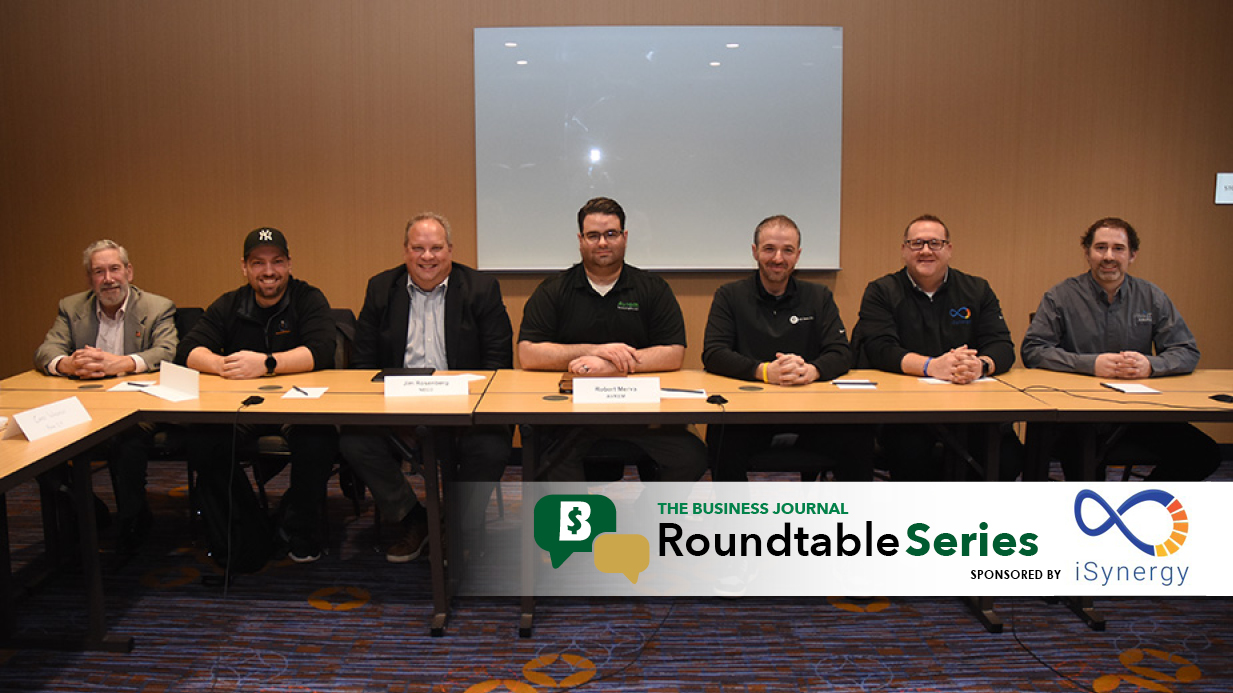This edition launches our 2023 Quarterly Roundtable Series, which will appear in print, online and on video. The series is sponsored by iSynergy, a digital marketing agency based in Canfield that provides branding, web design, content marketing and search engine marketing services.
Participants in the Business Technology Roundtable, held Feb. 7 at the Courtyard by Marriott in Canfield, were Steve Cross, president and CEO of iSynergy, Canfield; Tim Petrey, managing partner of HD Davis CPAs, Liberty Township; Robert Merva, owner, president and CEO of Avrem Technologies LLC, Canfield; Jim Rosenberg, president and CEO of NEO3, New Middletown; Dave Galioto, chief information officer of Executive Computer Management Solutions Inc., Struthers; Chris Wheatley, director of IT services at Peak I.T., Boardman; and Ralph Zerbonia, president and CEO of Universe Central Corp., Youngstown.
The Business Journal: Briefly describe your area of expertise as it relates to business technology and applications for business. What services or products does your company provide that incorporates the latest business technology?
Steve Cross, CEO, iSynergy Digital Marketing Agency: When you do marketing well, you integrate. And in today’s world, you have to integrate with a lot of different platforms.
You’ve got to use APIs [Automation Programming Interfaces]. You’ve got to deal with their ERP [Enterprise Resource Planning software]. You’ve got to deal with some custom software. You’ve got to pipe all that information together.
So how we use technology … it’s data-centric, keeping that data flowing from one silo to another within a company, and making sure on the forefront, when it comes to sales and marketing, that we’re putting all that data together and we’re utilizing it and being able to act on that data.

Tim Petrey, CEO, HD Davis CPAs: Our firm utilizes technology everywhere from bookkeeping to our advisory practice. We’re also very data-centric. So we’re working with our clients to help them collect the right kind of information so that they can monitor their financial successes and/or failures and learn and improve from that.
Robert Merva, CEO, Avrem Technologies: Our primary office is in Canfield. We have offices in Cleveland and Columbus as well.

We’re an IT managed-services provider. So the companies that hire us, hire us to handle 100% usually of their IT, although we have clients where we do co-managed IT services – where they have an internal IT department and we work with them. It stretches across everything.
We do help-desk support. We manage their networks, their computers, their servers, their governance and compliance risks, web development and design, web hosting. We call it “one throat to choke.” So one phone call to make to get everything that you need done.

Jim Rosenberg, CEO, NEO3: We sell, service, and support Oracle NetSuite ERP cloud solution exclusively. We’re very specialized that way. Oracle NetSuite is pretty much the leader in the industry in cloud ERP. We help our clients become more efficient by using ERP in the cloud. And like many of the folks here, we integrate just about anything that’s integratable.
Dave Galioto, CEO, Executive Computer Management Solutions Inc.: As a managed service provider, we help businesses utilize technology to improve their business, make themselves more efficient, keep them secure, protect them from outside threats. We work with partners all over the board, from different industries and sizes.

We do co-managed offerings. We do fully managed offerings where we take over the network and manage the whole infrastructure from the ground up. Or we’ll work with your internal IT team to manage your security suite for you, manage your patches, make sure your network is taken care of, that you’re productive and protected and stay up and running.
Chris Wheatley, Director of IT Services, Peak I.T. at Valley Office: We’re a full IT service provider, so solutions from everything like just Office 365 to email management, phone systems, networking, security.

For many of our customers, we do all of that. For some of our customers, we do just security or just for email. We also provide multi-function printers and copiers through our Valley Office side of the business. Often, we help on both sides of that from managing the network and setting up the copiers so they can scan to network shares, or really anything a business can come up with.
Ralph Zerbonia, CEO, Universe Central Corp.: We make software. Because of that, I get to surf on the leading edge of the next wave of whatever is new, generally in technology.

Recently the programmers we work with have been using artificial intelligence to create pieces of what they do as work. They’re just knocking away all of the drudge work and giving it to an AI mechanism that writes the code. So, we get to see a lot of different things and point them out to the general community.
We’ve been able to give to the community the technology that they need to bring them ahead. If you see a great domain name attached to a company, we sold it to them. We were in there very early on and made sure that they got those names. That’s why there’s Fireworks.com or TankHeads.com, et cetera.
The Business Journal: How is the business technology you provide accelerating the speed of business and productivity?
Petrey, HD Davis: Over the last two years, we’ve had roughly two decades of evolution in technology. We have been forced to adapt to something that none of us expected. But the benefit is that the technology has grown so fast.
So we have great technology that’s now supporting our remote offices, our outsource teams. We have great technology surrounding the automation of menial, monotonous tasks such as bookkeeping and some of the data collection surrounding business analytics.
It’s been a lot of fun to see that evolution. In the 10 years prior to that, we dragged along with some very slow evolution of technology. In the last three years, though, we’ve seen things like QuickBooks online grow to a whole different monster, platforms like Fathom and all the things that plug into products like QuickBooks online that can help small businesses compete with very, very large businesses.
Rosenberg, NEO3: Right. Great point. We do the same thing with NetSuite, a cloud-based product. Many of our clients were in a good position prior to COVID to be easily dispersed and become remote because [they could work] from any device anywhere, anytime. So when it was March 17, 2020, and everyone was told, “Hey, go home to work,” they were able to do that right away.
Also, the speed of delivery on new customers is much quicker. You can provision an account within 24 hours, have access to it and start functioning. You have access to the software in 24 hours and you could start setting it up and move forward quickly. For speed and efficiency, you can’t beat that.
In the old days we’d have to install software, download it, [provide] CDs, all that. Then we’d have to put it on a server. All that work has been taken from us. We just turn it on and go.
Zerbonia, Universe Central Corp.: Tim [Petrey], it’s interesting that you mentioned the last three years and the evolution because up until now, we’ve watched virtual reality and augmented reality sit there. Second Life’s been around for 30 years and no big deal. But because of the pandemic, now these are technologies that have entered the workforce. And they’re here to stay.
Cross, iSynergy: We don’t bring new software to our clients. We just utilize whatever they have. At the outset of the pandemic, everybody asked, how did you deal with it? What did you do? It was a 15-minute thing for us. People came into the office, grabbed their stuff, and went home. We already had Slack set up for our internal communication. We had our PM tool. We already had our QuickBooks online. We had all of our marketing automation platforms online.
Gmail – we were hosting on G Suite. So we had Google Meet already set up. We were ready to go.
Merva, Avrem: In 2017, we started forcing clients to come up with disaster recovery plans. So that transition in March and April [2020], we were busy, but it wasn’t a huge uptick in what we normally did.
The two biggest issues were: Some people still had a lot of desktop computers and we had to figure out the logistics. And then some people had really bad home internet connections we had to contend with.
For the most part, our clients were pick it up and go. You have to have the infrastructure to enable that. That’s not a decision that you can make and spin up in a month.
The cloud absolutely helps with that. But there’s prep work that has to go into that. You can’t make that decision and have it work immediately.
Wheatley, Peak I.T.: Going off of the pandemic and the changes we’ve had with that – we personally just saw a benefit for one of our customers that’s impacted by the train derailment [in East Palestine]. They are not allowed anywhere close to their offices. Yet they’re able to keep working.
We made a couple of changes to their phone system for their customers’ messages. They already had their laptops. They’re using Office 365, so they’re already set up to get their email from anywhere. And their cellphones are now ringing with their desk extensions.
They’ve been able to communicate with their customers and operate – not normally – but they’re able to answer their phones.
The Business Journal: What kind of business?
Wheatley, Peak I.T.: They’re a waste management business: garbage collection and removal.
The Business Journal: Were their trucks able to roll?
Wheatley, Peak I.T.: Originally they were able to get a vehicle on loan from another company. They did manage to get their trucks out of [the evacuation zone] at some point. [Norfolk & Southern Railroad] wanted them moved because of their proximity to the crash.
I don’t know the current status. But their phones are ringing and their email is working.
Galioto, ECMSI: The pandemic changed things and made us think differently about the way we do things remotely. With many of our partners we had gotten ahead of it. We have always preached DR [disaster recovery]: If you lose your building, what’s going to happen? If something happens here, how do we work remote? We’ve always had good disaster plans.
So when that time came, it was fairly easy to make those transitions. But again came challenges with home internet and securing the home networks.
It’s easy to secure inside your firewall and inside your network. But how do you secure your unprotected end points that you don’t manage and that your people use to access your data?
Merva, Avrem: We found one client that had a user with a dial-up connection.
Rosenberg, NEO3: America Online?
Merva, Avrem: Yeah, that’s what they were using.
The Business Journal: We can assume that because of the pandemic, people not up to speed got up to speed? That those who were profited greatly and kept going?
Cross, iSynergy: Anybody that was dragging their feet – [shakes his head].
It put them at a further disadvantage. … Either you’re going out of business or you need to adapt.
The Business Journal: Are most of the small businesses in our coverage area up to speed?
Merva, Avrem: No. Absolutely not. [Other participants nod in agreement.]
The Business Journal: Any percentages, any idea of where we stand compared to elsewhere?
Merva, Avrem: If the average company is three years behind the latest technology curve – a statistic I’ve heard repeated for years – then this Valley is another 10 years behind that. … It’s bad across the board; no matter what size you are, no matter how large you are, and no matter what the concerns are.
We still struggle getting people to take these things seriously. They look at it as a cost center. They don’t look at it as a revenue driver or enabler. I’m big on efficiency. They don’t even see it as an efficiency multiplier.
The Business Journal: Plus it’s a hassle for the companies.
Merva, Avrem: It is and it can be. But if done properly, there’s a lot of efficiency to be gained and things you could do to make it easier. We made it a goal, starting last year and going into this year, that every single client we have has to align with some kind of cybersecurity framework.
This is going to be the way of the future. And what it’s enabled us to do is, we don’t have to go in front of our client and say, “These are things that Avrem Technologies recommends.” We’ve been doing that for years.
But now we’ve got a framework written by a scientific or an academic body or a research body that we can point to and say, “This framework outlines all of the things that you need to do.”
It’s not us telling you to do this anymore. This is truly an industry standard best practice. And by getting that in front of people and letting them know that it’s not a cash grab – and it’s not us just spouting – it gives them something to work toward. And it makes it a little bit more accessible.
Petrey, HD Davis: Most places are terrified to make the change. In general, our community has lived in some constant state of fear for the last 40 years.
They’re afraid to charge the right price for the product that they’re offering. Therefore, they’ve made the same amount of money for the last 30 years. They took over their parents’ business. They charged the same thing over that period of time. And they don’t know how to make that transition.
It has to start even beyond understanding the dynamics of efficiencies and profits gained and disaster recovery plans by looking back at the core of their business and saying, “You can’t afford not to do this and here’s why. Here’s how to transition. Here’s what you need to adapt your business and to charge the right prices so that you have the money to afford all this infrastructure that you should have had 20 years ago.
Merva, Avrem: We have a lot of manufacturing clients. When they calculate the costs of services, parts that they’re making, the infrastructure it takes to run their business securely – that doesn’t even factor into the discussion. It’s not a thought most of the time.
Galioto, ECMSI: Correct. One of the big things we do is go into businesses and try to have a conversation with them about that. We refer to most of what we’re talking about as technical debt, meaning they haven’t put money into their infrastructure. And over the years, it’s just crumbling.
And then we work with that partner. One thing we like to do with all of our partners is build out roadmaps and show them how. We’ll break it down into manageable chunks, build it out on a five-year plan, keep them on a roadmap to keep their technology up to date so they maintain it and continue their efficiencies.
Rosenberg, NEO3: Change is driven only by some reaction to some event, not a proactive planning approach.
Galioto, ECMSI: Correct.
Rosenberg, NEO3: Right, where you say, “We’re going to do this in the next three years.” And they say, “No. We’re going to wait till our server crashes and call these guys and get it replaced.”
That’s a problem with some of the small businesses. It comes down to expense.[To] Tim [Petrey], what’s the normal percentage a company spends on IT? Six percent, 7% of their revenue per year? Roughly?
Petrey, HD Davis: Depends.
Rosenberg, NEO3: We’re lucky if we get 2% here. Right?
Petrey, HD Davis: Yes.
Rosenberg, NEO3: Two percent or 3%.
Zerbonia, Universe Central: This area has always been bad about spending money on technology.[To Rosenberg] I agree with you that all of them need help. But you find some bright stars out there, usually an individual or a huge company. That true for you?
Merva, Avrem: Yep. I shouldn’t be so doom-and-gloom.
Zerbonia, Universe Central: Individuals will go running off in the right direction, almost as if they were hobbyists with computers. They will always have the top-flight stuff.
But you don’t see it in the mom-and-pops. It’s a matter of money. We all run across it: What do you have to spend? What are you going to spend it on?
Rosenberg, NEO3: That’s it.
Wheatley, Peak I.T.: Much of it has to do with the history of the area as well. You look at the big businesses that were around or what’s been here. It’s manufacturing. It’s retail. And those are two of the segments that spend the least, traditionally, on IT.
So we get outside of that into the smaller businesses. But we still have that attitude from years of working for or with the manufacturing companies. Or, our family works for manufacturing. It’s hard for an area that views tech as maybe a necessity but something to be pushed to the bottom of the budget sheet. It’s hard to really address that because it’s been around for decades.
The Business Journal: That’s a really interesting point because in the area – you look at the steel industry. You look at the entirety of the demographics of our region and our history. It’s always been that way. There were points in time when we were industry leaders. Then it became Band-Aid.
Merva, Avrem: It really is the area. The area has a lot to do with it. We have clients in 21 states. We don’t get the pushback in some of the other states that we do in northeastern Ohio and western Pennsylvania.
Zerbonia, Universe Central: Look at how the steel mills left here. They left because they didn’t put any money into new technologies. They were using 1920s technology when they went down in the ’70s.
The Business Journal: The last blast furnace went up in 1944 for World War II production. Does anybody have anything else to add?
Wheatley, Peak I.T.: Just one thing. We have seen a bright spot that’s starting to push companies in the right direction. As there’s been more and more news of cyberattacks and cybersecurity instances that affect small and medium businesses, they’re looking for cybersecurity insurance. And the insurance providers are demanding that they make changes to their networks and their way of handling their technology infrastructure.
We’re seeing a lot of companies coming to us and saying we’re required to do this and this and this. Or, the state auditor is requiring us to do this – how can we do that?
So that’s given us an avenue into making improvements at companies that wouldn’t have been ready for it otherwise.
Zerbonia, Universe Central: Fear sells.
Merva, Avrem: To put it into perspective, the average insurance application that we would help clients with three to five years ago was one or two pages. It asked for top-line revenue, their big clients, to check a couple of boxes, and that was it.
The last insurance application I worked with a couple of weeks ago was 37 pages. Same coverage. Same company. Same insurance carrier.
That is a good indicator of how much this has changed in the last couple years and why we’re aligning to these frameworks. This is going to be how it is from now on.
The Business Journal: Let’s turn to artificial intelligence. In the simplest of terms, please explain how it works. How are AI business systems evolving and changing businesses? Are your clients using artificial intelligence? How should small businesses be using artificial intelligence? And what is the cost efficiency and ease of use?
Zerbonia, Universe Central: Artificial intelligence is training computers on history and letting them be aware of all that’s out there. So when you ask it a question, it’s going to look at all the things it’s seen and give you an answer based on that. Everyone here knows what a Captcha is when you go to a website. Do you think that Captchas are in the business of providing security to websites? You’d be mistaken.
Captcha is what asks you to identify all the traffic lights to make sure that you’re not a robot. Or it asks you to find the vehicles, et cetera. Its real business is to provide machine-learning data for artificial intelligence. When you have electric vehicles that are going to be self-driving, who do you think is training, is verifying that the picture has a red light in it so that when it’s shown to the machine, it knows what a red light looks like. You are when you do a Captcha.
Captcha’s business is to provide that data for artificial intelligence. You show a machine 600,000 red lights in all different perspectives from all different ideas. And it sees one in a different way. It can recognize it because it’s seen 600,000 of them. That’s how it works.
Rosenberg, NEO3: In a world of ERP, which I live in, AI is transitioning decision-support systems to decision-making systems. In the old days we provided data. The ERP system provided data to the users. We made our decisions based on that.
Now we’re skipping that part and going: Here’s the data. Here’s the decision. Done. Issue purchase orders automatically. Whatever. Supply-chain management plans.
All that is happening automatically based on the information that it has within the system. So it went from decision support to decision-making. The road is not smooth. There are some rocks in that road. But that’s where it’s headed.
NetSuite itself has AI built in for its decision-making, decision support. And all the ERP packages are having that now.
The Business Journal: So you provide software to the business. The business puts all of its information into that software. So what is an example of a decision? Should I buy more product?
Rosenberg, NEO3: Right. Not only does it look at the information that’s in your ERP – it’s pulling information from everywhere. Where would I buy it? What’s the cheapest path? What are the logistics? How should I ship it?
All of these things are happening like that, rather than having somebody sit in front of a computer and say, “Let me get a quote from three guys. Where should I get the freight? Who should handle the freight? Where should I buy this product? Should I buy it? How much should I buy? When should I have it delivered? When am I going to sell it?’
All these things are being determined in the background, and the issue I see with it is there’s no nuance. There’s no person there saying, “That sounds right.” Or, “That doesn’t sound right.”
But it’s certainly efficient, without a doubt.
Zerbonia, Universe Central: It’s Domino’s Pizza noticing that you buy a pepperoni pizza every Thursday at 5 p.m. and making sure that their location has the supplies to give it to you, eventually just curating it for you. You don’t even call in. You just get your pizza every Thursday night.
Merva, Avrem: It sounds very ethereal when we talk about AI. But in today’s real-world logistics, it is more like what Jim [Rosenberg] is talking about where it’s about decision-making. It’s about analyzing the data.
We’re moving to a model where the asset of the business is data. It’s not the servers and the computers and the hardware anymore or the infrastructure.
So what do you do with that data after it’s in the cloud and it’s not connected to anything? As costs have come down, as technology has gotten better, it becomes more accessible for businesses to utilize these tools to analyze something that they didn’t have the power to do before. Or it wasn’t cost-effective.
Petrey, HD Davis: In its simplest form, in the accounting and advisory space, a lot of our clients are utilizing products like QuickBooks online. And QuickBooks and Intuit have been the most popular platforms for small- to medium-sized businesses for decades. They’ve been building AI into their system for many, many years.
The simplest example I can give is, you write a check once a month to your landlord. When you code it, the system sees that check coming through your bank account. After you’ve told it on multiple occasions that it’s rent, AI now remembers that every time. So, we tell people as they set up their platforms that their accounting systems have become intuitive. They learn. They get better. They get more efficient.
The most important thing for us here locally is this huge generational gap. We have this huge generational exodus of the workforce that we have to replace. AI is a tool that can help us do that because it will help us automate some of the things that we used to have someone sit behind a machine [and do]. In its very basic sense, it can take care of some of those very menial tasks such as bookkeeping and/or just simple data collection for small- to medium-sized businesses.
The Business Journal: Steve [Cross], I wanted to call on you because you have a totally different use for AI.
Cross, iSynergy: To his [Merva’s] point, first-party data is currency. In every business, if you don’t look at it like that, you have a huge mistake in the way you’re looking at your business. It’s mindset.
If a company is pushing back, it’s because it’s not an early adopter. They’re not educating themselves to where they need to be.
But for AI, and the example of Domino’s, they’re going to get an email at 5:30: “Don’t you want your pizza today?” Because AI hit that automated-marketing platform, or a text, an SMS [short message service].
This is exactly the way that we would use AI based upon your data set, your intent. We do it a lot with targeting programmatic audience behavior, custom audiences, based upon a data set. Everything with AI is based upon a data set. Sometimes that data set is the internet. Sometimes that data set is my own business data.
But the way you said Youngstown is 10 years behind, I always say Youngstown is seven years behind.
Rosenberg, NEO3: Yeah.
Cross, iSynergy: Ten years from now we’re going to be watching this video roundtable and we’re going to be, “Oh, my gosh, we didn’t know what [faced us]. Because we’re on the fringe of where [AI] is, of how we utilize it and how we can capitalize on it. And in six months or two weeks or six years, it can do a complete 180 on every single one of our industries because it isn’t bound.
So let’s be progressive in our industries.
Zerbonia, Universe Central: We’re not going to have a choice. In Lordstown, Ultium is going to have thousands of workers go through there that are not going to be allowed to be old. They’re going to have to be up to date. They’re going to have to know new technology. They’re not just new companies that have come to Youngstown. They’re absolutely new industries.
Cross, iSynergy: Right.
Zerbonia, Universe Central: Nobody’s made batteries like that before. Nobody’s made a tractor that a mom-and-pop farm can buy and just put out in the field on its own using AI to have it do what it’s supposed to do. It’s like buying a hired hand-one that doesn’t go to the bathroom, doesn’t join a union, and doesn’t complain when you don’t feed it right.
The Business Journal: Let’s talk about generative AI and generating text images and sounds and other media. We know that it’s long been used by Meta and Google.
Most recently, we’re hearing about OpenAI, which unveiled a system that lets users generate photo-realistic images and so forth. OpenAI recently released a chatbot that answers questions in concise prose. Where is this headed? Are your clients using generative AI? How are local businesses using chatbots? How should they use generative AI?
Zerbonia, Universe Central: I saw this used [when] we had a website to launch – it had to do with racism. So I went to the ChatGPT and I put the following question in: How can we eliminate racism?
In three seconds I got a page [of text]. The page started out with a paragraph that described the problem. There were then six bullet points as to what you could do to eliminate racism that came from experts out there in the field.
It apparently just pulled their writings and pulled these things right out. And then it ended with a summary paragraph. It was well written and it said all the things that I would have wanted to get.
A month later I went back, did it again and it gave me eight more points. They were not the same points. They were different. But they were in the same vein.
I could see not just websites, people looking for text, but people look for answers that they were [asking] search engines. Now they’ll put [their question] into a ChatGPT box and they’ll get a real answer.
Galioto, ECMSI: That’s a good point, because I was talking to some of my guys about this the other day and somebody said it’s the new Google or it’s going to be the new Google because they’re going to it for troubleshooting problems that we can’t figure out.
Rosenberg, NEO3: News reports say ChatGPT is passing college-level exams on its own.
Galioto, ECMSI: It will write papers. It will –
Rosenberg, NEO3: And submitting papers that are grammatically perfect. And it’s a challenge for a lot of industries, specifically higher education.
Zerbonia, Universe Central: They’re worried about it in art. Because artists are saying, “This machinery captured my art and it’s not different from a human artist.”
If you went to art school or took art history, you would go through the same kind of thing that this machine learning is going to go through. And you’d then turn around and start producing art and nobody could accuse you of plagiarism.
Cross, iSynergy: To steal from one is plagiarism. To steal from many is research.
Rosenberg, NEO3: To your question: None of my clients has even dipped their toe in that water.
Cross, iSynergy: We’ve been using Copy.ai and Jasper AI for about two years to write a lot of our SEO [search engine optimization] blogs. It takes our time down, cuts it in half. We go from a six-hour blog down to about a two-hour blog. We’re talking anywhere from 1,000 to 3,000 words.
Everything you’re saying is absolutely correct. It’s research. It’s bringing in data, extracting it and putting it in a new formulation. What it doesn’t do is give an opinion. And that’s a huge thing for us.
For certain blogs and certain website content that we do, it’s factual and it’s truthful. But it’s not opinionated. And anybody that has a business and a brand needs to have a culture and an opinion and some level of humanity behind that.
That’s where we see the disconnect, where we can’t use it. Because we have some clients – like Mahoning County Visitors Bureau, Youngstown Live. We cannot use AI on any of that because they have specific [guidelines]. We talk about things to do in Youngstown on a date night. There are things that we have to hit.
We have ways to present that and ways to construct that [content] to deliver it. We’ve tried bending it and doing everything we can. But in that instance, you just can’t. Nothing we use today can replicate the human aspect of writing.
Petrey, HD Davis: This is one of those things that – if small businesses use it correctly – there’s a tremendous amount of opportunity to gain a competitive advantage. For the last 20 years, small businesses have been pushed down further and further by the Walmarts and Amazons of the world.
Now pieces of technology like this can help them in their content-creation strategies. Whether it’s SEO, whether it’s email newsletters, whether it’s LinkedIn, Facebook posts, they can use it as a guideline. They can use it as a map.
It’s still not something that is going to communicate their culture and their opinion. But at least now it gives them a roadmap. So the more small businesses looking at these things to gain a competitive advantage are the ones that are going to move along much faster, especially locally, because they’re going to gain little wins along the way.
The Business Journal: Is ChatGPT expensive?
Petrey, HD Davis: No.
Cross, iSynergy: No. Super cheap. Especially when you compare it to labor.
Zerbonia, Universe Central: There’s a skill involved – essentially the ability to ask the right question or to describe something that makes sense to the machine. If you’re asking for an art piece, all clip art is going to be replaced by this. You’re not going to bother. You’re just going to say, “I need a mouse. I need a bottle of pop and I need a plate.” And it will appear. So that kind of thing is going to replace that kind of work.
What you’re going to see can’t be described real well is in the manufacturing and technology businesses. Somebody must ask the right question: “What material could I use for this process that’s cheaper? What different process could I use that’s better?”
You’re going to get an answer. And you’re going to need to be an expert to understand the answer. But the answers might be those very answers that you’ve been seeking for 20 years.
That’s where, when it gets into operations, you’re really going to see a revolution.
Curing cancer. Knowing which molecule to go after. That might be something that we’d get out of machine learning a lot better than we get out of humans.
The Business Journal: What percentage of businesses that you deal with already have CRM [customer relationship management software] or use enterprise resource software?
Zerbonia, Universe Central: 20%.
Petrey, HD Davis: Wow!
Cross, iSynergy: We’re at 100%.
Wheatley, Peak I.T.: At the basic level, everybody is doing something.
Rosenberg, NEO3: Yeah.
Wheatley, Peak I.T.: But it might be a shared Teams document or an Excel sheet where you have different salespeople gathering in leads that way. In its most basic sense, that’s a CRM. As far as the more advanced stuff, we certainly have a few people that are using those types of platforms. But it’s still pretty rare.
Petrey, HD Davis: We work with almost exclusively small- and medium-sized businesses. A very small percentage of our clients use a true CRM. An even smaller percentage use it correctly.
Rosenberg, NEO3: Right, right.
Petrey, HD Davis: That’s something very few people are adapting to quickly. Again, because it’s not cheap in both the cost of the product and/or the time required to implement it correctly.
Rosenberg, NEO3: We have 100% – 100% of our clients have ERP and CRM, but 5% of them use it to its fullest. Or in the best possible way.
Merva, Avrem: That’s the key. Because closer to 80% of our clients have some kind of line of business application or CRM platform. But it’s whether they’re actually taking the time to take advantage of all the features. That’s the bigger problem.
Rosenberg, NEO3: That is the bigger problem.
Cross, iSynergy: But that’s software in itself.
Rosenberg, NEO3: Yeah.
Cross, iSynergy: You yourself as an IT company – how well do you use Windows operating system? Probably 40%.
Merva, Avrem: Our line of business application is called Autotask. We probably use – we’re much better than we were – only 80% or 90% of what we could be using.
Galioto ECMSI: Correct. And it’s an effort. You get other tools to add onto those tools and try to make that all work together. In any business, you’ve got your main line of business and this little sub-app that does one little thing, and you need to integrate that into your main application. There’s a whole challenge there.
Zerbonia, Universe Central: I’m having trouble keeping up with the improvements that come through every single day: Microsoft CRM. The Dynamics product. You can spend all day in documentation and not know the most recent improvement.
Rosenberg, NEO3: Correct.
Zerbonia, Universe Central: So using it correctly becomes an issue of eventually somebody like me transmitting it to one of my customers: This is new. You could use it in this way. There’s way too much to learn to use it 100%.
Merva, Avrem: Microsoft is a good example of a company that doesn’t make it easy on people either, because they come out with a new feature or they buy a new company or they put a bunch of R&D into something and then they change the name of it. Then, three weeks goes by and they’ve changed the whole thing all over again.
Cross, iSynergy: Then they sunset it.
Merva, Avrem: Exactly.
Cross, iSynergy: 100% of my clients use a CRM because we won’t take them on if they don’t. Simple as that.
The Business Journal: What is the metaverse? Is it a buzzword for virtual reality? And what is virtual reality? How does it work? Is augmented reality more likely to be the killer app? And where is all of this headed in terms of applications for businesses of all sizes?
Merva, Avrem: Second Life has been around for 30 years and it’s not a big deal.
To answer the first question – and this is not exactly my area of expertise – the metaverse is a virtual reality platform. It’s just Meta’s or Facebook’s version. It’s like saying a Marriott is a hotel.
There are a couple of problems with this. And I personally consider the metaverse to be a flop.
There’s the cost of adoption and the barrier to entry in getting involved. Teams does essentially the same thing. A couple years ago we were looking at the metaverse to solve the problem of how do you get people together in a collaborative way?
So Teams, Zoom, all of these kind of platforms that handle collaboration and communication, do that a lot easier with technology that people already understand. There’s not this huge barrier to entry. You don’t have a buy a VR headset. You don’t have to have a super-advanced computer.
So that barrier to entry needs to come way down. It needs to become more accessible. And the virtual reality space needs to go way up in quality, technology, design.
The metaverse is essentially a low-poly environment or something that’s very rough around the edges. We’re a long way from being able to get that level of detail and resolution and realism from the platforms we have today…
It must not be a cash grab like the metaverse was. Companies need to take a slightly different approach to get people to be interested in it.
Petrey, HD Davis: If you don’t believe that the concept of the metaverse is here to stay, you’re outside of your mind.
Merva, Avrem: I didn’t say that.
Petrey, HD Davis: This is one of those local challenges again. Talk to any grade-school kid and ask if they play Roblox.
Cross, iSynergy: Yeah. Or Minecraft.
Petrey, HD Davis: Roblox and Minecraft and all these platforms occupying this, quote/unquote, metaverse space. Is this virtual reality space where you can interact with people?
It’s very difficult for us in the United States to truly understand and appreciate the value of something like the metaverse because we have a beautiful place to live and we’re not living on top of one another, and we have access to resources that many other third world countries don’t have.
But if you give kids in India the opportunity to walk away from the uncomfortable living conditions of living on top of one another. In other parts of the world they don’t have access to the same resources we do. And they can hop into this, this metaverse in the Roblox and in any of those other platforms and live a different life. That’s a game-changer.
And that’s something that more people realize, that we’ve got to step away from just this little, little sliver of what we see here in the United States. These platforms are here to stay.
The same would have been said when I was growing up with the beginning of AOL and Google and the internet.[Metaverse] is the same idea.
The faster that people start to look at it and play with it, ask their kids about it, ask their kids to explain it to them, play video games with their kids and grandkids, you’re going to start to see some of the validity of those platforms and how you could integrate it into your businesses.
We’re still a ways away. But if we continue down this path we’ve gone through, we’ll be there before anybody knows it. …
Merva, Avrem: Oh, God, I’m old.
Petrey, HD Davis: Sorry, Bobby.
Rosenberg, NEO3: Welcome to the party.
Zerbonia, Universe Central: As you guys have all spent your lives working on computers and being in computers, so your children will be in the metaverse.
Cross, iSynergy: Yep.
Petrey, HD Davis: You got it.
Zerbonia, Universe Central: And the metaverse is a lot bigger than when it started in 1962 with a guy named Walter Wriston [the former CEO of Citibank] who put Citibank online and put the U.S. Treasury bills and notes online. That started the whole process.
The metaverse is a network with data that may or may not be virtual or augmented reality because the connection is the critical factor of the metaverse. That I can retrieve information from 1962 and get it from overseas and then communicate it to somebody all at one point, that makes it part of it. The virtual reality part, the augmented reality part, using the words of your question, is the killer app here. Because you don’t need expensive equipment.
Cross, iSynergy: Right.
Zerbonia, Universe Central: You can turn on your phone and the camera in it and just point it at something and whatever the augmentation shows up. [Holds up his iPhone.]
They’re using it in education right now so they don’t have to buy children headsets. And there’s plenty of businesses doing the same thing.
We’re seeing a little bit of it here. My company is a Microsoft partner. We sell the HoloLens. Pricey as hell. It’s a $3,500 headset. But what appears in front of you is magic.
Cross, iSynergy: Virtual desktops all around the room, yeah.
Petrey, HD Davis: Yeah.
Zerbonia, Universe Central: You can make anything you want to appear in front of somebody. Yet, they can still see you. They’re not hidden. That’s augmented reality.
In virtual reality, the entire environment in front of you disappears and a new one is provided. Augmented reality, you’re in the same environment but things are in front of you that other people don’t see if they’re not wearing a headset.
Cross, iSynergy: Going to their phone, Snapchat, your filters, that’s AR. That’s all it is.
Wheatley, Peak I.T.: For most of our small- and medium-sized companies, there’s probably not a lot of use of products like the HoloLens. But I can tell you for certain that big manufacturers in the area are experimenting with those. We know that Vallourec has done work with the HoloLens as well as other solutions, trying to come up with something.
You think of a maintenance person trying to rebuild a piece of equipment that maybe they haven’t worked on before, and being able to see, while they’re looking at the equipment, what it’s going to look like when they take off a piece or what it should look like when they rebuild it.
For smaller companies, some things that could be particularly useful are the landscaper having trouble with a problem weed at a customer’s site. You’ve got the camera, the Google Lens app to check out what that is and what’s going to kill it – and with a couple of taps to your screen, you’re on the campus of the Michigan State University ag site and it’s telling you how they killed weeds in southern Michigan. …
It’s along the same lines of where ChatGPT can be especially useful answering questions. Same thing with the augmented reality for the individual or the small business. That’s the big thing: the instant answer on something that otherwise you might have to take a picture of it and send it to somebody or take a clipping of it – going back to the example of a problematic weed, and showing it to other people. So you get that answer instantly now instead of taking days or weeks.
The Business Journal: How do we summarize what we’ve said today?
Cross, iSynergy: The thing I want to get out to the public is: Don’t be afraid of technology. Embrace it. Learn it. Educate yourself. How can I utilize technology? How can you utilize it in your business, your industry? And how can you capitalize on it to get a competitive edge?
The Business Journal: To what extent are people unaware of what they don’t know. And if they don’t know, how do they know what the problem is and how to fix it? Or if they should try to fix it?
Cross, iSynergy: It’s a mindset. Either you surround yourself with yes people who don’t challenge you and don’t bring new ideas, or you surround yourself with people who consistently challenge you and bring new ideas to you. It’s leadership – the way you lead and the type of leadership that you employ. I cite Steve Jobs: “I hire smart people and have them tell me what to do. If I’m the smartest person in the room in an internal meeting, I hired the wrong staff.”
Petrey, HD Davis: What a lot of small- to medium-sized businesses can do to start is ask the right questions and understand what you don’t know.
Do a tech stack analysis. Write down every piece of technology you use, what problem you’re trying to solve with that technology, and how much that technology costs. If you take the time to write down every variant piece of technology you’re using, the problem that it’s solving, and the cost associated, you’re going to be that much more prepared when it comes time to look at all the options. Or when you do find yourself in a room with someone who does know the answers to those things, when you bring in that consultant, when you bring in that tech company or your advisory company, to say, “This is all the software I’m using. Is there anything else I could be using? What solves these problems better?”
Merva, Avrem: The fortunate news is that people don’t have to decide these things for themselves and they don’t need to know what they don’t know. That’s why companies like mine exist, to help guide people in the right direction.
Small businesses need to understand that this is important. It’s important to their business and it’s important to their future. And then they need to get the right people on board and really leverage those people to help them.
Rosenberg, NEO3: Agreed. We’re all here in the business of change management. That’s what we do. We help people change. It’s incumbent upon us in the IT world to introduce these things to people and help them make their decisions based on the information that we’ve accumulated and guide them to the right place.
Galioto, ECMSI: Technology is not ever going away. You might as well embrace it and find yourself a trusted adviser if you don’t understand it.
Wheatley, Peak I.T.: And especially for those of us that are managed service providers – we have a responsibility to learn this stuff well so that we can teach customers.
The idea of businesses out there that don’t know what they don’t know – that’s really our role and responsibility, too, to help them learn and also show them ways they can do things better.
And especially from the service provider side of it – remembering that it’s not always about what solutions we can sell to the customer. Sometimes it’s about showing them a better way to do things because they don’t know all that is out there.
Zerbonia, Universe Central: In the next five years you’re going to see AI become pervasive and ubiquitous that a lot of the problems that you’re thinking of will be automatically solved by the AI saying to the person, “You don’t know this, but you need Excel for what you want to do.”
It will just happen in that way. Everything from kitchen appliances to your automobile to your desktop appliance, whatever you’re using, will start talking to you and telling you things.
That’s going to make a lot of what we all do go away and we’re going to have to operate at a higher level.
Copyright 2023 The Business Journal, Youngstown, Ohio.



